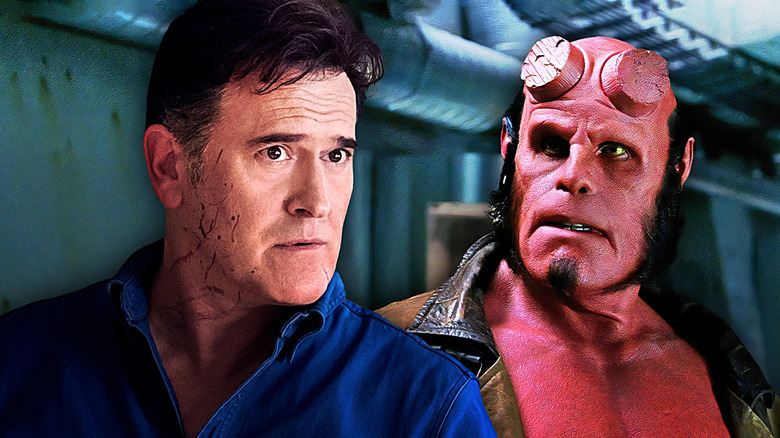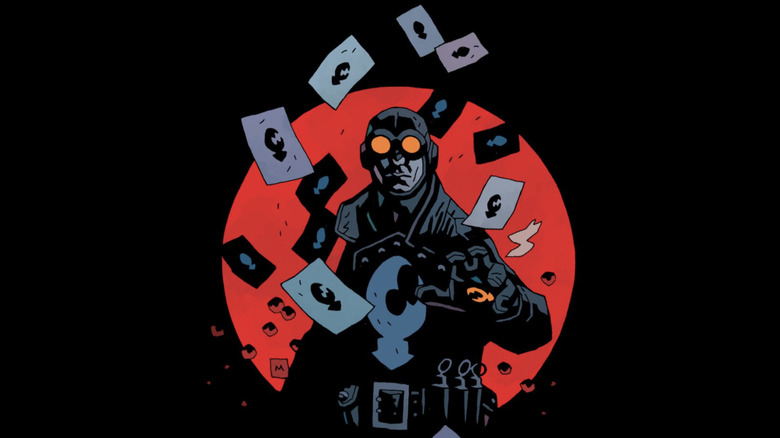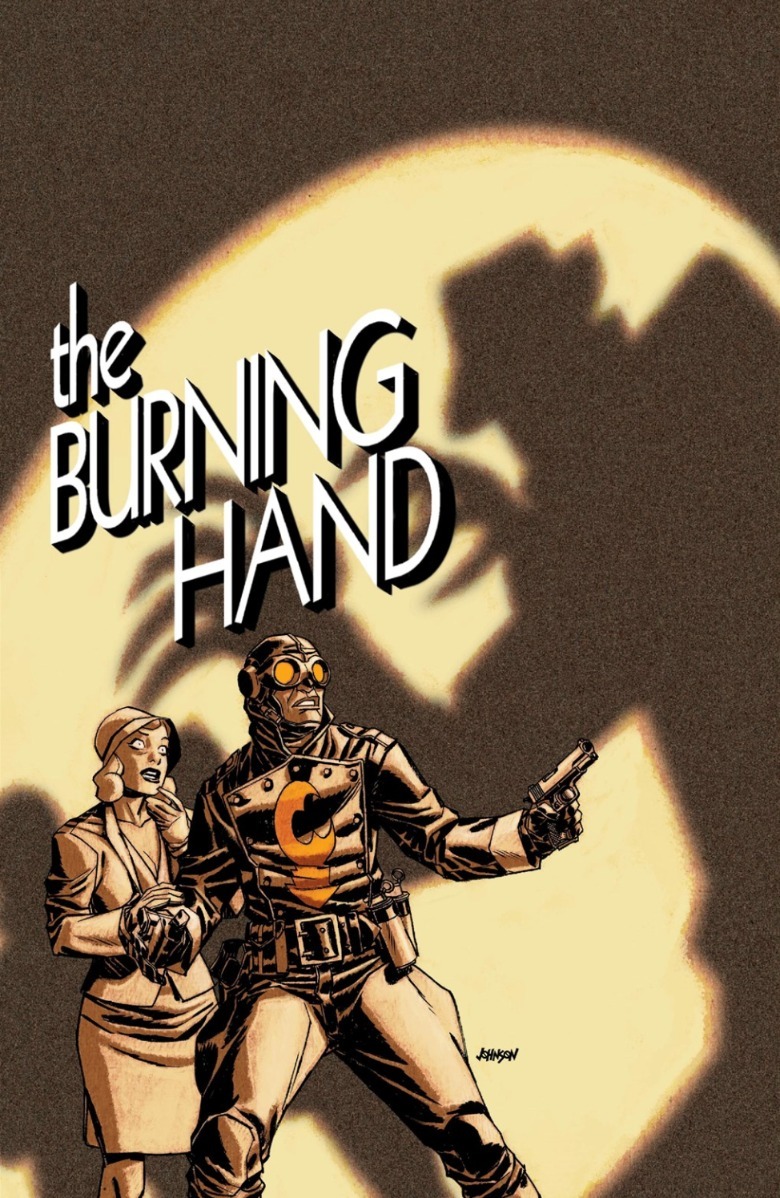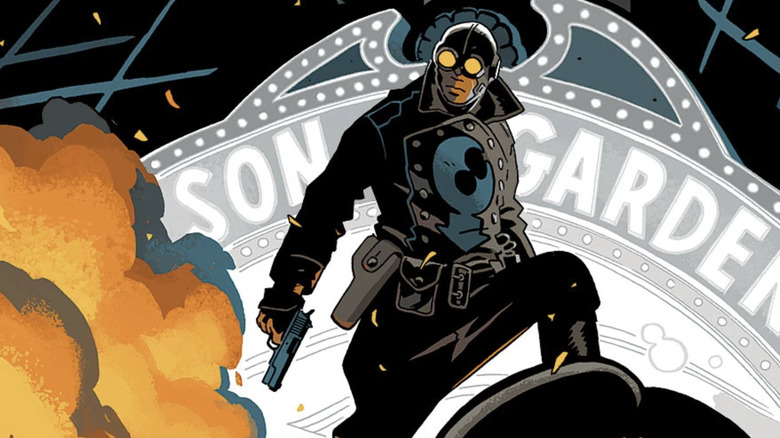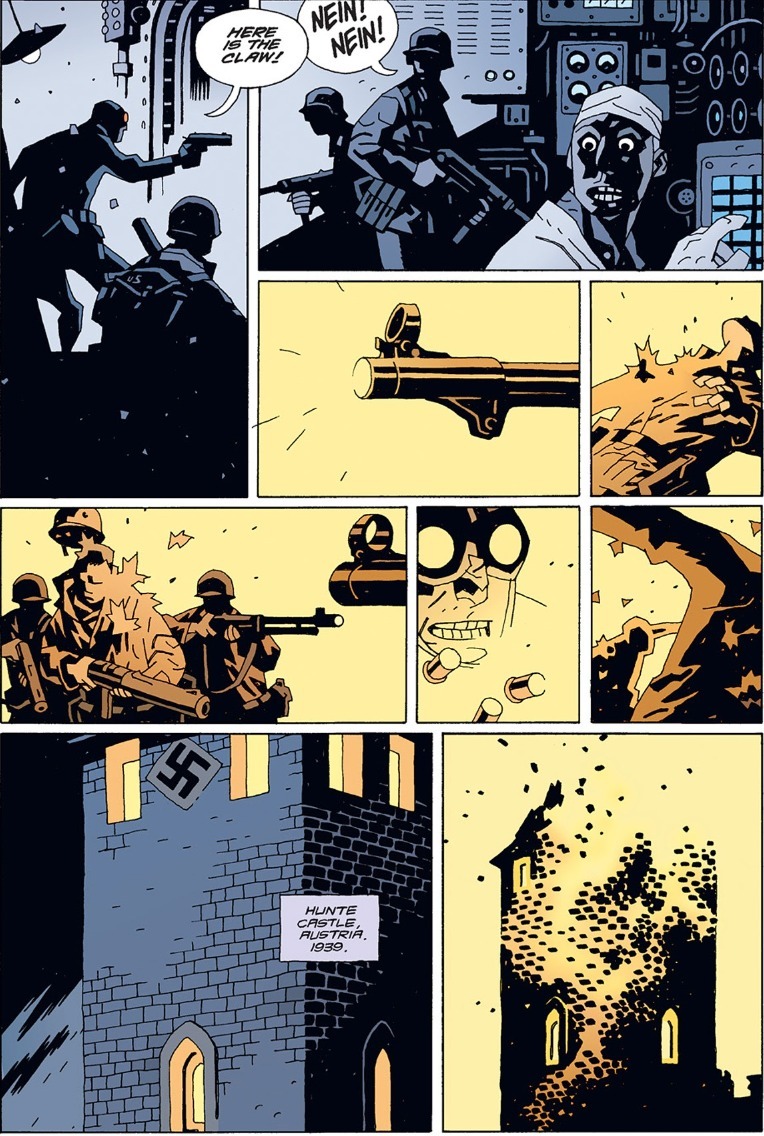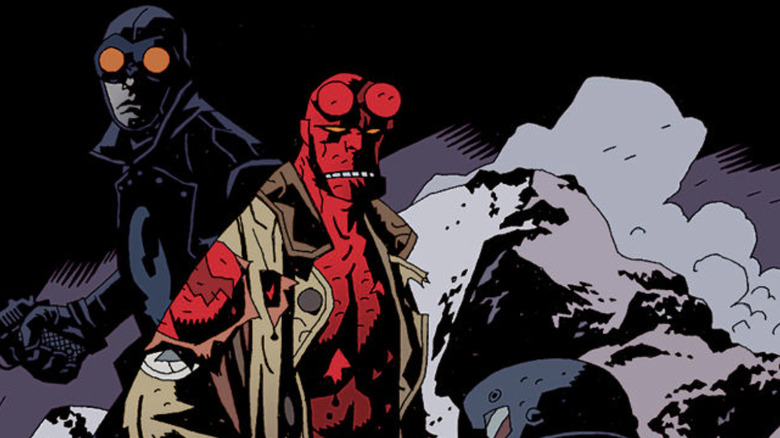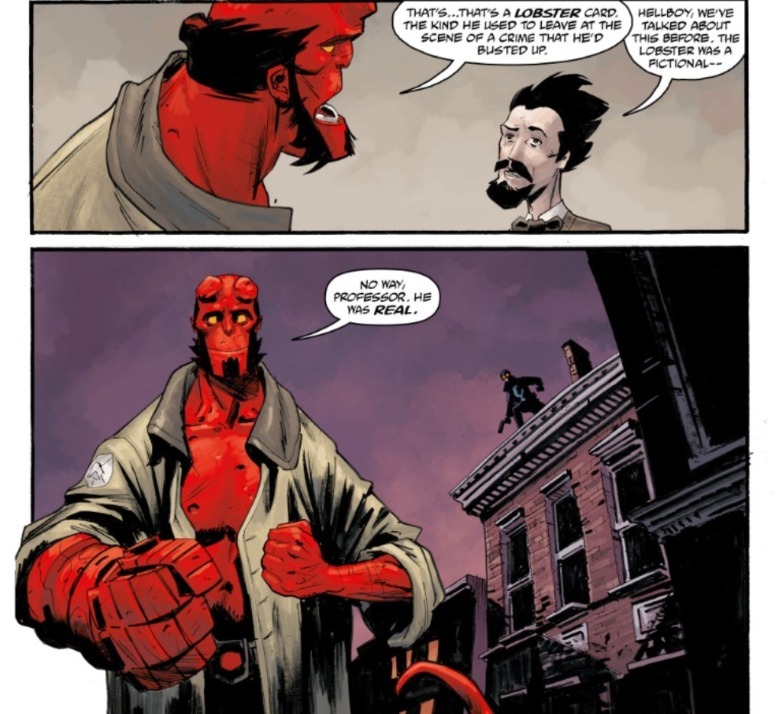Guillermo Del Toro Wanted To Cast This Legendary Horror Actor In Hellboy
We may receive a commission on purchases made from links.
Wherever Guillermo del Toro's "Hellboy" movies didn't quite match the original comics, del Toro confidently made the material his own. Hellboy (Ron Perlman), Abe Sapien (Doug Jones), and Liz Sherman (Selma Blair) all look like they stepped straight off the pages of Mike Mignola's original comics. Mignola wrote these three fantastical heroes like ordinary working stiffs working an extraordinary job, while the movie versions of these B.P.R.D. (Bureau for Paranormal Research and Defense) employees are less stoic, more romantic, and softhearted.
Changes in characterization aside, Perlman is perfectly cast as Hellboy and he's maintained he'd only come back to the franchise if del Toro did too. Yet del Toro's trilogy-wrapping "Hellboy III" has been unfortunately left for dead, cast into development hell in a most cruel twist of fate.
We have only an incomplete picture of del Toro's plans for "Hellboy III," and plans put into practice can and inevitably do change. Case in point, del Toro originally wanted "Hellboy II" to include another "Mignolaverse" hero. Speaking to Entertainment Weekly in 2006, two years before "Hellboy II" premiered, del Toro said he'd wanted to cast Bruce Campbell of "Evil Dead" fame as Lobster Johnson. "Sadly, Mike [Mignola] is very protective of Lobster Johnson," del Toro explained.
In the "Hellboy" universe, "the Lobster" was a masked vigilante active in early 20th century New York. From 1932 to 1939, he fought gangsters, Nazi spies, twisted scientists ,and occultists. His glove contained a heated-brand carved in the shape of his lobster claw insignia; he'd burn the lobster symbol into the foreheads of villains he defeated. The Lobster was later turned into the star of pulp novels and comics, which a young Hellboy read and adored.
Campbell would've been a perfect fit for del Toro's "Hellboy" — del Toro doesn't do farce like "Evil Dead" creator Sam Raimi does but his movies sometimes lean into horror comedy, which Campbell excels at. Seeing the actor share the screen with Perlman sounds like a team-up for the ages. Plus, Campbell looks like a superhero. (I'd like to live in the timeline where Campbell and Raimi made a Batman movie together in the '90s.) In "Army of Darkness," Campbell's Ash Williams is trying to be the action hero his chin deserves, but constantly failing.
Unsurprisingly, there are also now real "Lobster Johnson" comics, telling the "true" story of the hero's life. Mostly written by Mignola and John Arcudi ("B.P.R.D"), the comics' artists include Tonči Zonjić and Sebastian Fiumara. Buy why should you love Lobster Johnson as much as Hellboy himself does?
Bruce Campbell was Guillermo del Toro's pick to play Lobster Johnson in Hellboy
In the foreword of the first "Lobster Johnson" omnibus, Mignola wrote that he came up with the name "Lobster Johnson" before actually conceiving of who the character would be. He briefly considered making him a barbarian like Conan before he realized he could make the Lobster a spiritual ancestor to Hellboy instead.
"Hellboy" is a synthesis of pulp fiction, from adventure serials to Gothic ghost stories to Jack Kirby superhero comics. The Lobster, meanwhile, is an archetypal 1930s pulp hero modeled on the Shadow and the Spider. (These are the fictional adventurers who also inspired Batman, though these earlier heroes and the Lobster himself do not have Batman's rules against guns and killing.) Comics featuring the Lobster often have covers that look like they belong on the wall of a Great Depression-era movie house:
In the "Hellboy" story "Wake the Devil," Mignola referenced a legendary occult investigator named Edward Grey. Making the Lobster was the next step in building out the "Hellboy" universe after that. As Mignola once wrote:
"[Edward Grey] was my nod to those Victorian occult detective characters that were a big influence on Hellboy, just as those pulp heroes of the '20s and '30s (Doc Savage, the Shadow, the Spider, etc.) were. So I figured that if I was going to have my Victorian guy, I was also going to need a '30s-style, gangster-battling, mystery vigilante guy."
The Lobster has a crew of helpers, just like the Shadow did, and is also a fanatic for justice. But rather than the fedora and cape combo the Shadow and the Spider wore, the Lobster wears a black leather jacket (adorned with a blue lobster claw), a chin-strap helmet, and orange-lensed goggles. Those goggles are what complete the design by adding a slight color contrast to the all-black outfit. The comics hold plenty of panels where the Lobster is concealed completely by shadow — except for his unblinking eyes.
Lobster Johnson in Hellboy, explained
Mignola first introduced Lobster in the short story "Killer In My Skull" (a back-up to the Hellboy two-parter, "Box Full of Evil"). He then brought Hellboy and the Lobster together for the 2001 mini-series, "Conqueror Worm."
In 1939, the Lobster was recruited to stop a rocket launch by Nazi scientist Herman Von Klempt at the Austrian Hunte Castle; he did not survive. The comic cold opens with the mission, narrated by the Edgar Allan Poe poem from which the comic nicked its title. Colorist Dave Stewart keeps the art in stark blue and black, suggesting the coldness of night and the past — until the castle explodes and fries the Lobster.
Decades later in "Conqueror Worm," Hellboy and Roger the Homunculus are sent to stop an undead Von Klempt, still operating out of Hunte Castle. They get some help from the Lobster's ghost, who cannot pass on until seeing his mission through. Making the Lobster a ghost reflects how the cultural moment of pulp heroes like him has passed, but his influence lingers on in new characters like Hellboy. "Conqueror Worm" is Mignola's boldest melding of horror and pulp, before later "Hellboy" stories drifted more into fantasy.
Mignola has admitted he has "a real problem with trying to write a character's adventures in any kind of chronological order." So, with the Lobster's fate already set in stone, he went back to his 1930s exploit when he was still flesh and blood. Trying to cross-reference the internal chronology of the "Hellboy" universe with publication order is more trouble than it's worth. This has never been a true drawback, though, because Mignola and his stable of creative partners write most of the comics on their own terms. I promise, you don't need to know anything about Hellboy to enjoy "Lobster Johnson." But the comics do shed some light on the Lobster himself.
The first published (but last chronological) Lobster Johnson comic mini-series, "Iron Prometheus," includes fill-in pages "The True History of Lobster Johnson." This explains how he went from real vigilante to pulp myth.
Lobster Johnson completes Hellboy
After the Lobster's death, pulp novelist Norvell Cooper wrote eight novels about the Lobster from 1939 to 1942. He invented a backstory and secret identity for the Lobster — millionaire Walter Johnson. Hence, Lobster Johnson (a name the real Lobster never used). That in turn inspired a short-lived "The Lobster" comic series during World War II, which is where Hellboy first met his hero, and several (terrible) low-budget films in the '40s and '50s. (Rumors suggest Mr. del Toro is directing a modern remake.) All those who wrote the Lobster died in poverty and ignominy, staying true to the sad fates of real pulp icons, from Conan author Robert E. Howard to Superman creators Jerry Siegel & Joe Shuster.
Due to the Lobster's mysteriousness, his unrecorded death, and fictionalized adventures, the public in "Hellboy" believes he was only a fictional character. Hellboy keeps the faith he was real because of the string of gangsters in the 1930s who had lobster claws burned into their flesh. Hellboy is usually stoic and stiff, but his childhood hero the Lobster can make him light up.
The comics explain everything about the fictional Lobster Johnson, but precious little about the real Lobster. To this day, Mignola and co. have never given the Lobster a real name or backstory to explain his vigilantism, beyond an iron-strong devotion to violent justice. It's suggested he might be the descendant of past "Lobsters" (such as 18th century Spanish pirate El Bogavante), but the reader is left to make their own conclusions.
So, could Campbell still have a chance to wear the Lobster's claw? It was rumored he'd been cast to play the Lobster in the 2008 "Hellboy" video game "The Science of Evil," but that didn't pan out. There were also plans for an animated "Hellboy" movie featuring the Lobster, "The Phantom Claw," that fell through just like del Toro's "Hellboy III." The Lobster finally made the jump from the comics to the screen in 2019's "Hellboy" film, as played by Thomas Haden Church, but he felt shoe-horned in and was too minor a player to make an impression. For now, Lobster Johnson is best served by the place Hellboy first met him and Mignola first wrote him: the comics.
